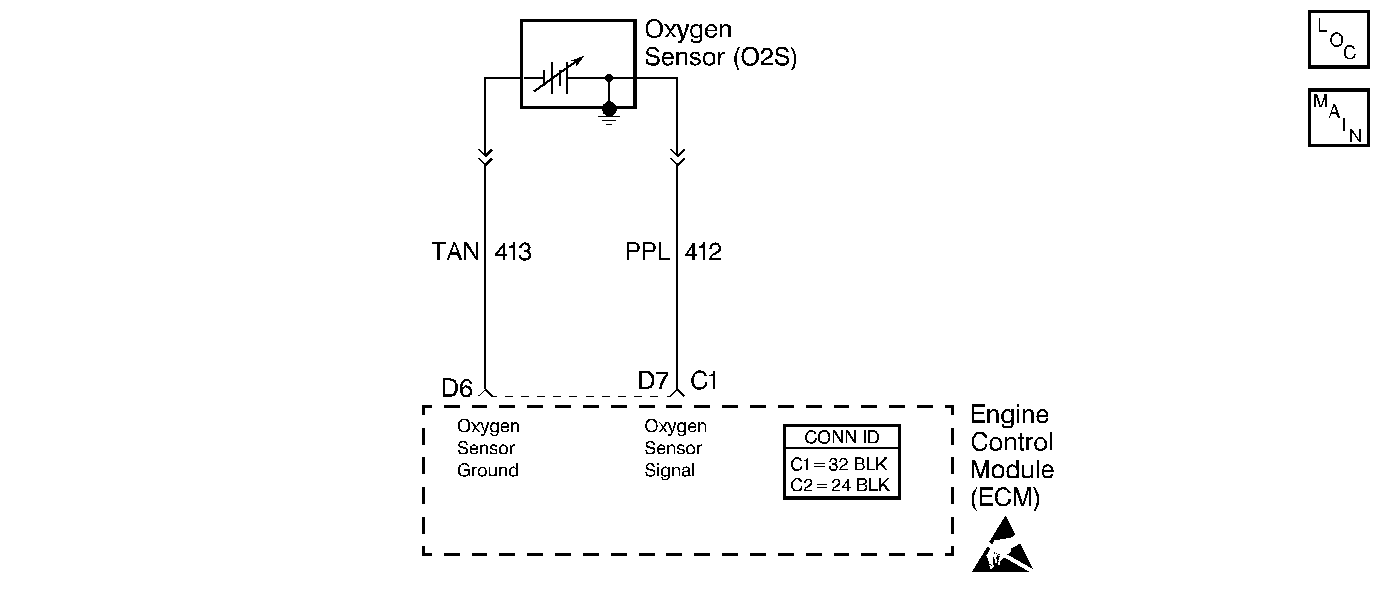
Circuit Description
The ECM supplies a voltage of about 0.45 volt between terminals D6 and D7. (If measured with a J 39200 , this may read as low as 0.32 volt.) The Oxygen Sensor (O2S) varies the voltage within a range of about 1.0 volt if the O2S signal is rich, down through about 0.10 volt if O2S signal is lean.
The sensor is like an open circuit and produces no voltage when it is below about 300°C (600°F). An open sensor circuit or cold sensor causes Open Loop operation.
Conditions for Setting the DTC
| • | O2S signal remains above 0.7 volt. |
| • | System operates in Closed Loop. |
| • | Throttle angle is greater than 5%. |
| • | All conditions must meet for 30 seconds. |
Action Taken When the DTC Sets
The Malfunction Indicator Lamp (MIL) will illuminate. The system will go Open Loop.
Conditions for Clearing the MIL/DTC
The conditions for the fault are no longer present and 50 ignition cycles have passed with no further faults or the ignition switch is turned OFF and the battery feed voltage is removed for 10 seconds.
Diagnostic Aids
| • | Using the scan, observe the long term fuel trim values at different RPM and air flow conditions. If the conditions for DTC 45 exists, the long term fuel trim values will be around 115. |
| • | Fuel pressure -- The system will go rich if pressure is too high. The ECM can compensate for some increase. However, if the fuel pressure gets too high, a DTC 45 may be set. |
| • | Refer to Fuel System Diagnosis . |
| • | Leaking injector. |
| • | Check for fuel contaminated oil. |
| • | Electromagnetic Interference (EMI). An open ground CKT 453 (IC reference low) may result in Electromagnetic Interference (EMI), or induced electrical noise. The ECM looks at this noise as reference pulses. The additional pulses result in a higher than actual engine speed signal. The ECM then delivers too much fuel, causing system to go rich. The engine tachometer will also show higher than actual engine speed which can help in diagnosing this problem. |
| • | EVAP canister purge. Check for fuel saturation. If full of fuel, check canister control and hoses. Refer to Evaporative Emission Control System Diagnosis . |
| • | MAP sensor. An output that causes the ECM to sense a higher than normal manifold pressure (low vacuum) can cause the system to go rich. Disconnecting the MAP sensor will allow the ECM to set a fixed value for the MAP sensor. Substitute a different MAP sensor if the rich condition is gone while the sensor is disconnected. |
| • | TP sensor. An intermittent TP sensor output will cause the system to go rich, due to a false indication of the engine accelerating. |
Test Description
The number below refers to the step number on the Diagnostic Table.
Step | Action | Value(s) | Yes | No |
|---|---|---|---|---|
1 | Did you perform the On-Board Diagnostic (OBD) System Check? | -- | ||
Does the scan tool display the Oxygen Sensor voltage fixed greater than the specified value? | 75-95°C (167-203°F) 1,200 RPM 0.75 V (750 mV) | Go to Diagnostic Aids | ||
3 |
Does the scan tool display voltage less than the specified value? | 0.35 V (350 mV) | Go to Diagnostic Aids | |
4 | Replace the ECM. Refer to Engine Control Module Replacement . Is the action complete? | -- | -- | |
5 |
Did the DTC reset? | -- | ||
6 | Are any DTCs stored which you have not diagnosed? | -- | Go to the Applicable DTC Table | System OK |
